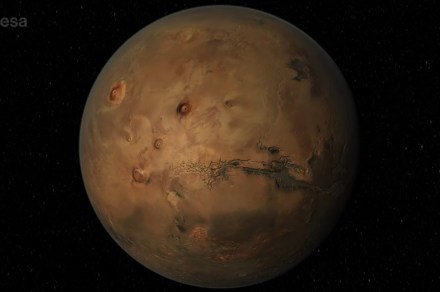ESA/DLR/FU Berlin & NASA/JPL-Caltech/MSSS
A new video shows what it would be like to cruise over the surface of Mars, zooming in to the planet from orbit and into a channel called the Ares Vallis. Created from data taken by the European Space Agency’s (ESA) Mars Express mission, it shows the region where NASA’s Pathfinder mission landed in 1997.
Fly around Ares Vallis on Mars
Credit: ESA/DLR/FU Berlin and NASA/JPL-Caltech/MSSS. Data processing/animation: Björn Schreiner, Image Processing Group (FU Berlin)
The important stops along the journey are labeled in the video so you can see the sights of Mars as the camera passes over them. The flight is across a region called Oxia Palus, which covers a huge area of over 300,000 square miles, which hosts the famous Ares Vallis channel.
ESA/DLR/FU Berlin & NASA/JPL-Caltech/MSSS
The tour begins with Mars as seen from orbit, with a rectangle indicating the area where the tour will be focused. On zooming in to the region, you can see the varied terrain of the Mars surface, beginning with the Pathfinder landing site where the Sojourner rover explored. Then the channel of the Ares Vallis comes into view — stretching over 1,000 miles in length, it is one of Mars’s longest outflow channels.
Channels like this are important for scientists to study as they show where water once flowed on the planet’s surface, allowing researchers to build up a picture of which regions were rich in water — and where life could possibly have evolved.
As the tour continues, two craters come into view. Named Masursky and Sagan, there is also evidence that water was here, too, as the rim of the Masursky crater shows erosion likely caused by water from the Tiu Valles system located nearby.
Another notable feature of the crater is the jagged, jumbled rocks located within it. Known, rather dramatically, as chaos terrain, these ridges and plains are often seen on Mars and are related to the historical presence of water as well. “Its distinctive muddled appearance is thought to arise when subsurface water is suddenly released from underground to the surface,” ESA explains. “The resulting loss of support from below causes the surface to slump and break into blocks of various sizes and shapes.”
Further craters are visible along the tour, many of which also have evidence of once being filled with water. You can see the direction in which the water once flowed from the tail shapes left on the surface.
Finally, the channel comes to an end in the smooth Oxia Planum region, where ESA’s Rosalind Franklin rover will land following its launch in 2028, before the camera zooms out to show the whole region in all its fascinating glory.
Georgina has been the space writer at Digital Trends space writer for six years, covering human space exploration, planetary…
How NASA is using AI on the Perseverance rover to study Mars rocks
Space engineers have been using AI in rovers for some time now — hence why today’s Mars explorers are able to pick a safe landing site and to drive around a region autonomously. But something they haven’t been able to do before now is to do science themselves, as most of that work is done by scientists on Earth who analyze data and point the rover toward targets they want to investigate.
Now, though, NASA’s Perseverance rover is taking the first steps toward autonomous science investigation on Mars. The rover has been testing out an AI capability for the last three years, which allows it to search for and identify particular minerals in Mars rocks. The system works using the rover’s PIXL instrument (Planetary Instrument for X-ray Lithochemistry), a spectrometer that uses light to analyze what rocks are made of. The software, called adaptive sampling, looks though PIXL’s data and identifies minerals to be studied in more detail.
Read more
Mushroom houses: NASA wants to grow its own Mars habitats from fungi
Bricks produced using mycelium, yard waste, and wood chips as a part of the myco-architecture project. Similar materials could be used to build habitats on the Moon or Mars. NASA
When future astronauts set out for the moon or for Mars, they’ll need some shelter. And while you might imagine cities on other planets being made of steel, or glass, or some high-tech carbon fiber compound, NASA has other ideas. The agency is funding research into growing their own habitats out of fungi.
Read more
How to watch SpaceX’s triple-booster rocket take its 10th flight on Tuesday
The Falcon Heavy rocket on the launchpad at the Kennedy Space Center in Florida ahead of its ninth flight in December last year. SpaceX
SpaceX is about to send its powerful Falcon Heavy rocket skyward in its first mission since December last year.
Read more





GIPHY App Key not set. Please check settings